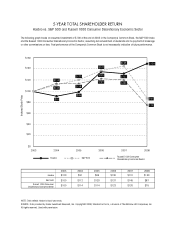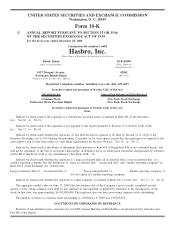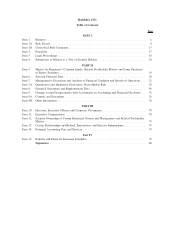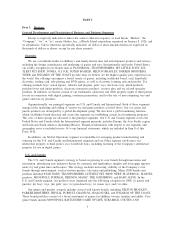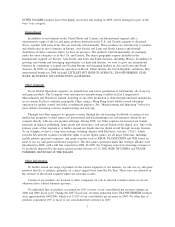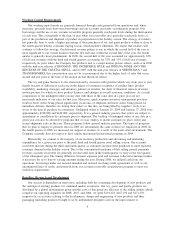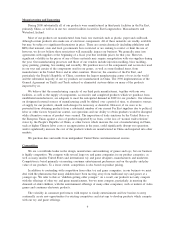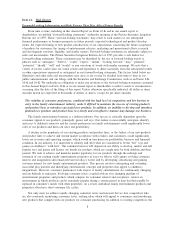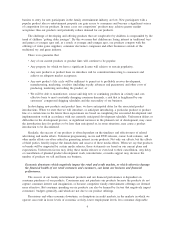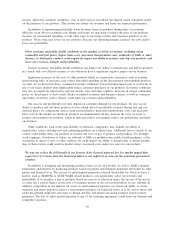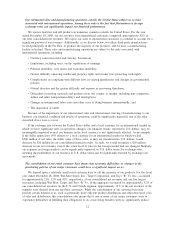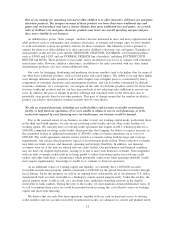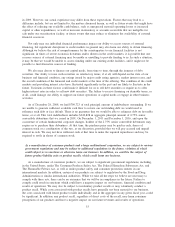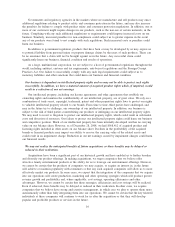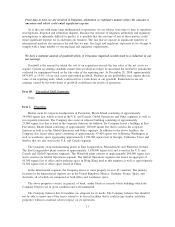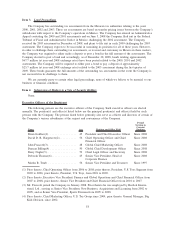Hasbro 2008 Annual Report Download - page 18
Download and view the complete annual report
Please find page 18 of the 2008 Hasbro annual report below. You can navigate through the pages in the report by either clicking on the pages listed below, or by using the keyword search tool below to find specific information within the annual report.
Item 1A. Risk Factors
Forward-Looking Information and Risk Factors That May Affect Future Results
From time to time, including in this Annual Report on Form 10-K and in our annual report to
shareholders, we publish “forward-looking statements” within the meaning of the Private Securities Litigation
Reform Act of 1995. These “forward-looking statements” may relate to such matters as our anticipated
financial performance or business prospects in future periods, expected technological and product develop-
ments, the expected timing of new product introductions or our expectations concerning the future acceptance
of products by customers, the timing of entertainment releases, marketing and promotional efforts, research
and development activities, liquidity, and similar matters. Forward-looking statements are inherently subject to
risks and uncertainties. The Private Securities Litigation Reform Act of 1995 provides a safe harbor for
forward-looking statements. These statements may be identified by the use of forward-looking words or
phrases such as “anticipate,” “believe,” “could,” “expect,” “intend,” “looking forward,” “may,” “planned,”
“potential,” “should,” “will” and “would” or any variations of words with similar meanings. We note that a
variety of factors could cause our actual results and experience to differ materially from the anticipated results
or other expectations expressed or anticipated in our forward-looking statements. The factors listed below are
illustrative and other risks and uncertainties may arise as are or may be detailed from time to time in our
public announcements and our filings with the Securities and Exchange Commission, such as on Forms 8-K,
10-Q and 10-K. We undertake no obligation to make any revisions to the forward-looking statements contained
in this Annual Report on Form 10-K or in our annual report to shareholders to reflect events or circumstances
occurring after the date of the filing of this report. Unless otherwise specifically indicated, all dollar or share
amounts herein are expressed in thousands of dollars or shares, except for per share amounts.
The volatility of consumer preferences, combined with the high level of competition and low barriers to
entry in the family entertainment industry, make it difficult to maintain the success of existing products
and product lines or introduce successful new products. In addition, an inability to develop and introduce
planned new products and product lines in a timely and cost-effective manner may damage our business.
The family entertainment business is a fashion industry. Our success is critically dependent upon the
consumer appeal of our products, principally games and toys. Our failure to successfully anticipate, identify
and react to children’s interests and the current preferences in family entertainment could significantly lower
sales of our products and harm our sales and profitability.
A decline in the popularity of our existing products and product lines, or the failure of our new products
and product lines to achieve and sustain market acceptance with retailers and consumers, could significantly
lower our revenues and operating margins, which would in turn harm our profitability, business and financial
condition. In our industry, it is important to identify and offer what are considered to be the “hot” toys and
games on children’s “wish lists”. Our continued success will depend on our ability to develop, market and sell
popular toys and games and license our brands for products which are sought after by both children and their
parents. We seek to achieve and maintain market popularity for our products through the redesign and
extension of our existing family entertainment properties in ways we believe will capture evolving consumer
interest and imagination and remain relevant in today’s world, and by developing, introducing and gaining
customer interest for new family entertainment products. This process involves anticipating and extending
successful play patterns and identifying entertainment concepts and properties that appeal to children’s
imaginations. However, consumer preferences with respect to family entertainment are continuously changing
and are difficult to anticipate. Evolving consumer tastes, coupled with an ever changing pipeline of
entertainment properties and products which compete for consumer interest and acceptance, creates an
environment in which products can be extremely popular during a certain period in time but then rapidly be
replaced in consumer’s minds with other properties. As a result, individual family entertainment products and
properties often have short consumer life cycles.
Not only must we address rapidly changing consumer tastes and interests but we face competitors who
are also constantly monitoring consumer tastes, seeking ideas which will appeal to consumers and introducing
new products that compete with our products for consumer purchasing. In addition to existing competitors, the
8


